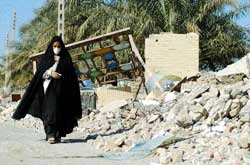 That night, Farina's uncle and aunt called her from Bam. They told their niece they had heard deep rumbles from beneath the earth. Scared, they spent the whole freezing night in the car parked outside their house. Before dawn, they called another of Farina's uncles in Karman to tell him they were now going in for morning prayer.
That night, Farina's uncle and aunt called her from Bam. They told their niece they had heard deep rumbles from beneath the earth. Scared, they spent the whole freezing night in the car parked outside their house. Before dawn, they called another of Farina's uncles in Karman to tell him they were now going in for morning prayer. "We got to Bam at eight in the morning," Farina recalls. "When we reached the house we saw my uncle and aunt had been crushed to death. Their prayers did not save them"
There are thousands of stories of death, suffering and also miraculous rescues from that earth-shattering event at 5:30 in the morning of 26 December last year in this historic eastern Iranian city. In 12 seconds, more than 40,000 people were killed and 120,000 injured. More than 2,000 children in Bam were orphaned.
Like Farina, most families have lost at lest two relatives in the catastrophe. One elderly Iranian dressed in black tell us she lost 30 members of her clan in three villages near Bam. "Some of them were alive when they were rescued from the rubble, but died soon after. Some were unrecognisable because they were crushed by the concrete."
One mother lost her eight-year-old daughter. "She had gone to sleep with her doll the previous night. At 5:30 there was a terrible roar, the house came down, we ran out, there was dust everywhere," the mother recalls in a low voice, and then breaks into sobs: "We found her in the ruins of her room, still clutching her doll. She looked like she was still sleeping." She shows us the ragged and dusty doll, the only reminder of her daughter. "This is the last thing she touched, and she loved it so."
I arrived in Bam one month after the tragedy as part of an international health and relief effort. As a Nepali, everywhere I looked I foresaw what will happen to us when an earthquake strikes our country. As in Iran, in Nepal we shouldn't say 'if' an earthquake strikes but 'when'. That there will be an earthquake of this magnitude in Kathmandu or other Nepali towns is a certainty. We just don't know when it will happen.
 Nearly two months after the earthquake, Bam is still in utter shock. There is a four storey building in the centre of town that could easily be one of those new office blocks that are coming up in Kathmandu. My companion tells me it used to be seven stories high-but the first three floors were simply crushed like an accordion. The ruins of collapsed buildings are everywhere. Piles of bricks, dust, cement slabs, steel rods, crushed refrigerators, shoes, books lie scattered.
Nearly two months after the earthquake, Bam is still in utter shock. There is a four storey building in the centre of town that could easily be one of those new office blocks that are coming up in Kathmandu. My companion tells me it used to be seven stories high-but the first three floors were simply crushed like an accordion. The ruins of collapsed buildings are everywhere. Piles of bricks, dust, cement slabs, steel rods, crushed refrigerators, shoes, books lie scattered. Here in Bam, I am constantly reminded of my grandmother's stories of the great 1934 earthquake and the one that struck eastern Nepal 15 years ago. Bam is proof of what will happen to Kathmandu when a quake of this intensity strikes our capital. Kathmandu's urban planners, architects, businessmen should be brought on a tour of Bam to see what it is like. This is what Asan, Indrachowk, the new government buildings, the fancy villas, the office blocks will look like after a quake.
They should think about rescue and rehabilitation in the aftermath of an earthquake. Those still alive will face epidemics, mental and physical agony, hunger and thirst aside from bereavement. There will be a lack of medical facilities, no water, electricity or sanitation. We won't even know how many people died, because we don't know how many live in Kathmandu's crowded core.
In Bam, I came across a woman who appeared unwell. She was recovering from a leg injury sustained during the quake. I asked her if there was anything I could get her. She replied that she could use some feminine hygiene items and some lipstick. We both started laughing and soon her family and my translator joined in. Despite the pain, I am touched by the generosity, compassion and sense of humour among the Iranians I have met. When we travel to nearby villages to check on health needs, particularly of women, we are often asked to come into tents and share cups of tea. We hear "Ba formain. Chai dusdari?" so often that we start understanding the Farsi for "please come in, would you like some tea?"
We are offered dates and fruits, even from families who have nothing left. Bam is famous for its date orchards. Every family has an orchard, even if it is just a few trees. Most families live in tents among their trees. The roads survived the quake, which has helped the relief work.
Busy with my work, I help Iranian women with their problems, share their sorrow and try to make their present more bearable. But all along, my mind is faraway in Nepal. The unthinkable that could happen in my own homeland.
Aruna Uprety is a Nepali doctor who has worked in rural western Nepal, Afghanistan and is currently posted in Iran.



